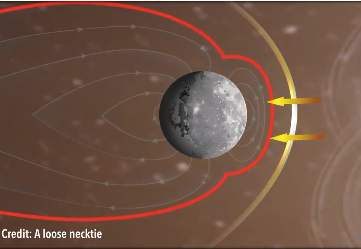As the closest planet to the Sun, Mercury is hot. Like, unimaginably hot.
作为离太阳最近的行星,水星上温度很高。难以想象的热。
Temperatures on the surface can reach more than 400 degrees Celsius, and yet, back in 2012, NASA’s MESSENGER spacecraft spotted something incredible: masses of water ice on Mercury’s surface.
水星表面的温度可以超过400摄氏度,然而,早在2012年,美国宇航局的信使号飞船却发现了一些不可思议的东西:水星表面有大量的大块冰。
Previously, radar telescopes on the ground had picked up patches of something bright and reflective in some of the planet’s craters, so this discovery confirmed scientists’ suspicions.
此前,地面上的雷达望远镜曾在水星的一些陨石坑中捕捉到一些明亮的反射物,因此这一发现证实了科学家的猜测。
The question was, though, how.
但问题是,这种现象是如何出现的呢。
How could ice survive on one of the solar system’s hottest planets, and how did it get there in the first place?
冰是如何存在于太阳系最热的行星上的?它最初是如何出现在那里的?
Based on recent research, the answer might be stranger than you’d think.
根据最近的研究,答案可能比你想象的更奇怪。
Mercury’s ice may not exist in spite of the heat, but because of it.
水星上存在冰并不是因为没有热量,而正是因为有热量。
Now, we’re talking about a place that’s way too hot for liquid water, let alone the frozen kind!
我们讨论的可是一个温度高到不可能有液态水的地方,更不用说冰了!
But when you’re that close to a massive body like the Sun, it’s not just the temperature that matters—the gravity does too.
但当你非常接近像太阳这样的大质量天体时,影响你的不仅仅是温度,还有重力。
On average, Mercury is about 60% closer to the Sun than the Earth is—close enough that the difference between the Sun's pull on the near side and the far side is pretty significant, especially when it passes closest to the Sun.
平均而言,水星离太阳的距离比地球近60%,太阳对近日端和远日端的引力差别相当大,尤其是当它经过离太阳最近的地方时。
On top of that, Mercury is not a perfect sphere—it’s slightly stretched, and its stretched parts act like handles that the Sun tugs inward when it makes that closest approach.
最重要的是,水星并不是一个完美的球体——它是稍微拉伸的样子,而它拉伸的部分就像把手一样,当太阳靠近水星时,它会把把手向内拉。
In the past, that repeated tug slowed down the planet’s rotation until it was locked to its period around the Sun.
过去,这种反复的引力会减慢水星的自转速度,直到它被锁定在围绕太阳的周期上。
Today that same tug keeps Mercury locked in that pattern.
现在,同样的拉力让水星继续保持着那个模式。
As a result, for every two years on Mercury, the planet experiences one day.
因此,水星每两年才经历一天。
And it lasts for nearly 176 Earth days.
它持续了将近176个地球日。
So, each day, each side of the planet spends over 4000 hours under the scorching Sun, and over 4000 hours in pitch darkness.
因此,每一天,水星的一面有超过4000小时在灼热的太阳下,另一面超过4000小时在漆黑的黑暗中。
And as anyone who lives through Arctic winters will know, without the Sun’s heat for weeks on end, it can get seriously cold.
任何一个经历过北极冬季的人都知道,如果连续几周没有太阳的热量,那里会变得非常寒冷。

That’s especially true on Mercury, which doesn’t have much of an atmosphere to trap heat, so the night side is directly exposed to the extreme cold of space.
在水星上尤其如此,那里没有太多大气层来储存热量,所以处于黑暗中的那一面直接暴露在太空的极度寒冷中。
In fact, during the night, temperatures on the surface can plummet to minus 180 degrees Celsius—which is colder than it gets on Mars.
事实上,在夜间,水星表面的温度会骤降至零下180摄氏度——比火星上的温度还要低。
And that’s where Mercury’s ice collects—in particular, in craters near the poles where shadows keep it dark and cold for even longer.
这就是水星的冰聚集的地方——尤其是两极附近的陨石坑,那里的阴影让水星的黑暗和寒冷持续的时间更长。
So, that’s one mystery solved, but it doesn’t explain how the water got there in the first place.
所以,这个谜题破解了,但它并不能解释水最初是如何出现在那里的。
See, when the Sun first ignited, about four-and-a-half billion years ago, its heat kept water molecules from forming unless they were about four times as far as where Earth orbits now.
大约45亿年前,太阳第一次点燃时,它的热量阻止了水分子的形成,除非它们离太阳的距离是现在日地距离的四倍。
So scientists think that all of the water in the inner solar system must have been delivered later, by asteroids from farther out that collided with the planets after they formed.
因此,科学家们认为,太阳系内部所有的水一定是后来由更远的小行星在行星形成后与它们相撞而产生的。
That’s the leading explanation for how the Earth got its oceans full of water, and until recently, scientists figured that was how Mercury got its water ice, too.
这是对地球上海洋形成的主要解释,直到最近,科学家们还认为这也是水星形成大块冰的原因。
But it’s not the only explanation anymore.
但这已经不是唯一的解释了。
A 2020 study published in the Astrophysical Journal Letters suggests that Mercury may be creating that water… all by itself.
2020年发表在《天体物理学杂志通讯》上的一项研究表明,水星可能是......自己在制造水。
According to their model, it all starts when energetic charged particles from the Sun strike the surface of the planet.
根据他们的模型,这一切都源于来自太阳的高能带电粒子撞击地球表面。
Mercury is especially exposed because of its lack of atmosphere—and while it has a weak magnetic field, lots of particles can still make it right through.
由于缺少大气,水星特别容易暴露在空气中,而且尽管它的磁场很弱,但许多粒子仍然可以通过。
Many of them are hydrogen ions, and when those hit the surface, they react with elements in the soil to create hydroxyl groups, which are molecules made of oxygen and hydrogen.
它们中的许多是氢离子,当这些氢离子接触到土壤表面时,它们与土壤中的元素发生反应,产生羟基,这是一种由氧和氢组成的分子。
On the day side of Mercury, the extreme heat gives the hydroxyl groups a lot of energy, so they begin moving around rapidly and reacting with each other.
在水星白天的一侧,极端的热量给羟基提供了大量的能量,所以它们开始快速移动并相互反应。
Those reactions produce water vapor and hydrogen gas, which rise off the surface of the planet and drift around.
这些反应会产生水蒸气和氢气,这些气体会从水星表面上升并漂移。
Some of the molecules react further and get broken down, but some stick around long enough to drift over to the night side and land in craters.
有些分子会进一步反应并分解,但有些分子会停留很长时间,漂移到夜晚的一侧,落在陨石坑里。
There, without the Sun’s heat, they freeze.
在那里,没有太阳的热量,它们就会结冰。
Some of these craters are deep enough that they never see the Sun, and over thousands of years, they’ve turned into significant patches of ice.
有些陨石坑深到无法看到太阳,经过数千年的时间,它们已经变成了很明显的冰块。
This mechanism isn’t unique to Mercury—it happens on our Moon too, in tiny amounts.
这种机制并不是水星所独有的——它也发生在我们的月球上,只是数量很少。
But on Mercury, the scorching temperatures on the day side and the constant barrage of solar particles make it a much bigger deal.
但是在水星上,白天一侧的灼热温度和连续不断的太阳粒子让它的规模更大。
And according to the authors of the study, this method likely accounts for about 10% of Mercury’s ice.
根据这项研究的作者,水星通过这种方式形成的冰可能占所有冰层的10%。
But while the remaining 90% likely did hitch a ride to Mercury on asteroids, those asteroids needed to get their water from somewhere, too.
但是,即便剩下的90%可能是借助小行星到达水星的,这些小行星也需要从其他地方获得水。
And according to the study’s lead author, they may have produced their water through the same process.
根据这项研究的第一作者,它们可能是通过同样的过程产生水的。
In fact, this research may even help us understand how water and ice got to other places in the solar system.
事实上,这项研究甚至可以帮助我们了解水和冰是如何到达太阳系的其他地方的。
Which isn’t a lesson most of us expected to learn from Mercury!
这可不是我们多数人希望从水星身上学到的东西。
Thanks for watching this episode of SciShow Space!
感谢收看本期《太空科学秀》!
We’re still learning a lot about Mercury because, even though it’s pretty close as far as cosmic things go, it’s not that easy to get there!
关于水星我们还要了解很多,尽管就宇宙万物而言,它离我们很近,但要到达那里也并非易事!
And if you want to find out more, you might like our episode on how we send probes to Mercury.
如果你想了解更多,你可能会喜欢我们如何向水星发送探测器的那期节目。











